This study examines the problem of tactical survivability for divisional CSS units on the AirLand battlefield. In exploring this issue the study focuses on (1) Soviet threat forces capable of interdicting divisional rear areas; (2) the US Army's rear battle doctrine outlining tactical responsibilities for CSS units; and (3) the tactical adequacy of current CSS equipment and training. The Soviet Union in its military doctrine and force structuring continues to place great emphasis on developing multiple techniques and means to exploit deep into the enemy's rear areas. The US Army's rear battle doctrine relies upon a system of mobile reaction forces and static defenses to protect our rear areas from the Soviet threat. Reaction forces by design are committed to a situation after the fact, therefore, CSS units will initially be required to engage enemy combat forces, a mission for which they are poorly equipped and inadequately trained. The development and fielding of survivable CSS equipment has not kept pace with weapons development in our combat units. CSS training has not placed an adequate emphasis on developing tactical skills in CSS organizations or its soldiers. The concentration of effort in CSS training is on technical skill training. The study concludes that divisional CSS units are not adequately equipped or tactically trained to survive on the AirLand battlefield. The study also includes recommendations to overcome the perceived shortfalls in CSS equipment and training.
Hinweis: Dieser Artikel kann nur an eine deutsche Lieferadresse ausgeliefert werden.
Hinweis: Dieser Artikel kann nur an eine deutsche Lieferadresse ausgeliefert werden.








